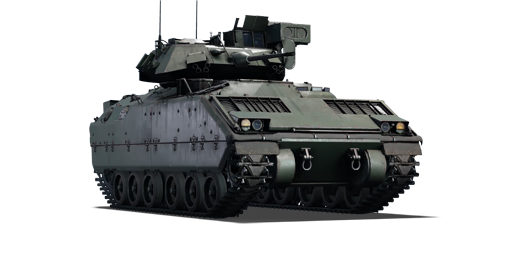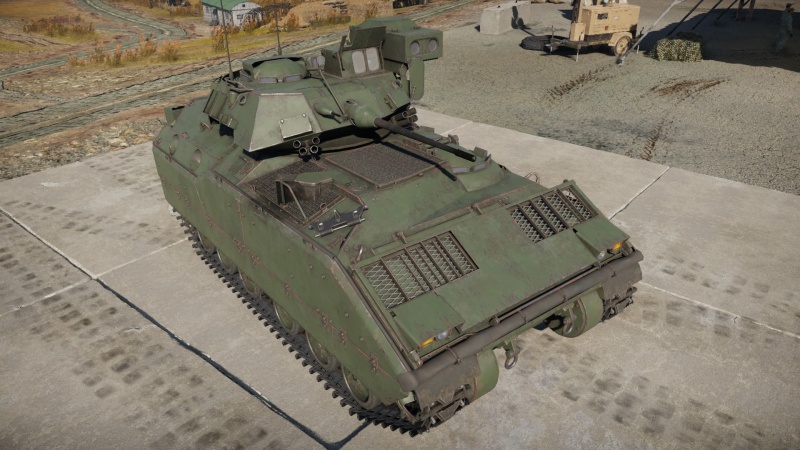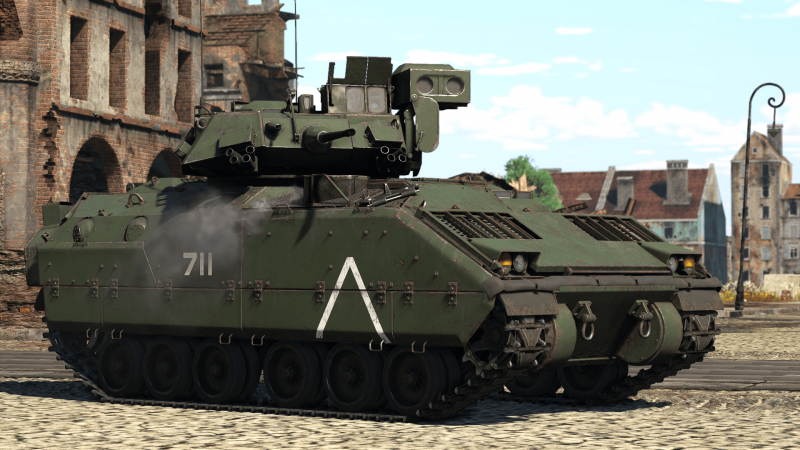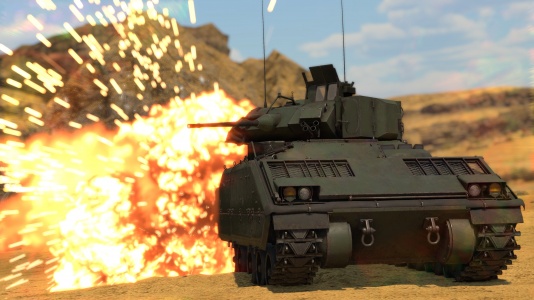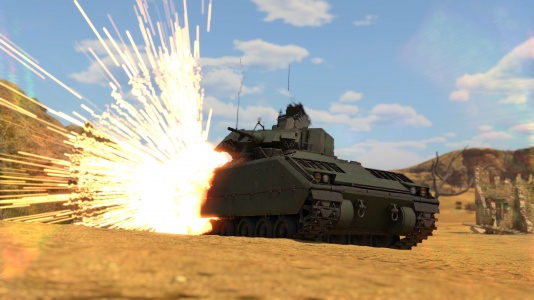Difference between revisions of "M3 Bradley"
m (→Pros and cons: Rephrased a lot of bullets) (Tag: Visual edit) |
Colok76286 (talk | contribs) (Edits) |
||
| (6 intermediate revisions by 5 users not shown) | |||
| Line 14: | Line 14: | ||
== Description == | == Description == | ||
<!-- ''In the description, the first part should be about the history of the creation and combat usage of the vehicle, as well as its key features. In the second part, tell the reader about the ground vehicle in the game. Insert a screenshot of the vehicle, so that if the novice player does not remember the vehicle by name, he will immediately understand what kind of vehicle the article is talking about.'' --> | <!-- ''In the description, the first part should be about the history of the creation and combat usage of the vehicle, as well as its key features. In the second part, tell the reader about the ground vehicle in the game. Insert a screenshot of the vehicle, so that if the novice player does not remember the vehicle by name, he will immediately understand what kind of vehicle the article is talking about.'' --> | ||
| − | The | + | The search for the ideal mechanized infantry combat vehicle (MICV) in the US military began as early as 1964, but design dissatisfaction and the Vietnam War complicated the procurement process while introducing new requests in what the US wants in their infantry fighting vehicle (IFV). A breakthrough to the final design was made when the FMC Corporation designed XM723 MICV was considered for the vehicle of choice for the IFV as the XM2 IFV, though the design was complicated again by having to also fit with the US Cavalry requirement as the XM3 Cavalry Fighting Vehicle (CFV). Following evaluations and criticism of the overall program, the XM2/3 was provided production approval in January 1980 as the M2 and M3 Bradley. Though both the infantry and cavalry variant shared similar exterior looks, the cavalry differed with the infantry seat area configured to contain more ammunition and missiles for the M242 chain gun and TOW launchers. As improvements were introduced into the design, the original M2/M3 variants were designated with an "A0" suffix. Though some A0s were sent before the onset of Operation Desert Storm in 1991 (both M2A0 and M3A0 consisted of 19% of all Bradleys in theater), the A0s were more intended as attrition spares while the improved A1 and A2 variants were sent into combat. |
| + | |||
| + | Introduced in [[Update 1.85 "Supersonic"]], the M3 Bradley remains a relatively unique vehicle in the American lineup as an infantry fighting vehicle. Like in real-life, players would have to handle the Bradley's relatively large size alongside main battle tanks and its paper-thin armour against both kinetic and chemical shells. The mobility is nothing spectacular to write home about either aside from being able to get the Bradley from point A to point B in a suitable manner. That said, the variety of firepower it is able to dish out makes it a lethal machine. The APDS shells the autocannon armament fires can penetrate more than a few tanks from the side armour, not to mention being able to make mincemeat out of lightly armoured vehicles. However, when facing tanks or faraway targets, the TOW missiles are a great piece of tool to have to ensure a critical hit even from far out, the only downside being the long missile launcher deployment time from when the Bradley is moving to coming to a halt. | ||
== General info == | == General info == | ||
| Line 63: | Line 65: | ||
* '''M791:''' {{Annotation|APDS|Armour-piercing discarding sabot}}{{-}}{{Annotation|APDS|Armour-piercing discarding sabot}}{{-}}{{Annotation|APDS|Armour-piercing discarding sabot}}{{-}}{{Annotation|HEI-T*|High-explosive incendiary tracer (self-destroying)}} | * '''M791:''' {{Annotation|APDS|Armour-piercing discarding sabot}}{{-}}{{Annotation|APDS|Armour-piercing discarding sabot}}{{-}}{{Annotation|APDS|Armour-piercing discarding sabot}}{{-}}{{Annotation|HEI-T*|High-explosive incendiary tracer (self-destroying)}} | ||
| − | { | + | {{:M242 (25 mm)/Ammunition|APDS, HEI-T*}} |
| − | |||
| − | |||
| − | |||
| − | |||
| − | | | ||
| − | |||
| − | |||
| − | |||
| − | |||
| − | |||
| − | |||
| − | |||
| − | |||
| − | |||
==== [[Ammo racks]] ==== | ==== [[Ammo racks]] ==== | ||
| Line 113: | Line 101: | ||
==== Ammunition ==== | ==== Ammunition ==== | ||
| − | { | + | {{:BGM-71A TOW/Ammunition|TOW}} |
| − | |||
| − | |||
| − | |||
| − | |||
| − | |||
| − | |||
| − | |||
| − | |||
| − | | TOW | ||
| − | |||
| − | |||
| − | |||
| − | |||
| − | |||
| − | |||
| − | |||
| − | |||
| − | |||
| − | |||
| − | |||
| − | |||
| − | |||
| − | |||
| − | |||
| − | |||
| − | |||
| − | |||
| − | |||
| − | |||
==== [[Ammo racks]] ==== | ==== [[Ammo racks]] ==== | ||
| Line 194: | Line 153: | ||
* Excels at urban combat, as the gun can be effective when engaging MBTs, except for the Russian MBTs | * Excels at urban combat, as the gun can be effective when engaging MBTs, except for the Russian MBTs | ||
| − | |||
* Outclasses stock 35 mm autocannon tanks which use API or APHE as long as long-range (about 1.1 km) and moderate front armour angle is kept, can even sustain low calibre APDS and HVAP hits from spaded light tanks if it has the high ground | * Outclasses stock 35 mm autocannon tanks which use API or APHE as long as long-range (about 1.1 km) and moderate front armour angle is kept, can even sustain low calibre APDS and HVAP hits from spaded light tanks if it has the high ground | ||
* Can fire missiles at "combat" cruise control, albeit only at about 5 km/h (can be considered as a downgrade after [[M551]], but still usable when compared to its peers) | * Can fire missiles at "combat" cruise control, albeit only at about 5 km/h (can be considered as a downgrade after [[M551]], but still usable when compared to its peers) | ||
| − | * | + | * 25 mm autocannon can easily tear through light vehicles and is useful for engaging helicopters |
* TOW missiles capable of penetrating many tanks from the front with ease | * TOW missiles capable of penetrating many tanks from the front with ease | ||
* Has a fast turret traverse and two-plane stabilizer, allowing for quick reaction times and accurate fire on the move | * Has a fast turret traverse and two-plane stabilizer, allowing for quick reaction times and accurate fire on the move | ||
| Line 207: | Line 165: | ||
* Additional side armour plates and turret frontal slope protect against 12.7 machine guns, but will always set off APHE, so caution is required | * Additional side armour plates and turret frontal slope protect against 12.7 machine guns, but will always set off APHE, so caution is required | ||
| − | * Low fire rate on the autocannon; faster than the British | + | * Low fire rate on the autocannon; faster than the British 30 mm RARDEN but slower than the Russian 30 mm 2A42 and most SPAA autocannons |
* Survivability is poor as with other IFVs; its autocannon belt is easy to hit and the vehicle is prone to overpressure | * Survivability is poor as with other IFVs; its autocannon belt is easy to hit and the vehicle is prone to overpressure | ||
* Relatively slow, especially in reverse | * Relatively slow, especially in reverse | ||
| Line 248: | Line 206: | ||
;Videos | ;Videos | ||
| − | {{Youtube-gallery|2h5kFyznXKU|'''Best IFVs''' discusses the {{PAGENAME}} at 1:24 - ''War Thunder Official Channel''|p6_wtLInMRc|'''{{PAGENAME}} - I Expected More''' - ''Napalmratte''|wpm0DcBWhIA|'''The Shooting Range #126''' - ''Pages of History'' section at 05:52 discusses the {{PAGENAME}}.}} | + | {{Youtube-gallery|EqBcQom4ilU|'''M3(A3) Bradley Ultimate Review''' - ''Bob Dickinson''|2h5kFyznXKU|'''Best IFVs''' discusses the {{PAGENAME}} at 1:24 - ''War Thunder Official Channel''|p6_wtLInMRc|'''{{PAGENAME}} - I Expected More''' - ''Napalmratte''|wpm0DcBWhIA|'''The Shooting Range #126''' - ''Pages of History'' section at 05:52 discusses the {{PAGENAME}}.}} |
== See also == | == See also == | ||
Latest revision as of 12:33, 10 May 2024
| This page is about the American light tank M3 Bradley. For the other version, see M3A3 Bradley. For other uses, see M3 (Disambiguation). |
Contents
Description
The search for the ideal mechanized infantry combat vehicle (MICV) in the US military began as early as 1964, but design dissatisfaction and the Vietnam War complicated the procurement process while introducing new requests in what the US wants in their infantry fighting vehicle (IFV). A breakthrough to the final design was made when the FMC Corporation designed XM723 MICV was considered for the vehicle of choice for the IFV as the XM2 IFV, though the design was complicated again by having to also fit with the US Cavalry requirement as the XM3 Cavalry Fighting Vehicle (CFV). Following evaluations and criticism of the overall program, the XM2/3 was provided production approval in January 1980 as the M2 and M3 Bradley. Though both the infantry and cavalry variant shared similar exterior looks, the cavalry differed with the infantry seat area configured to contain more ammunition and missiles for the M242 chain gun and TOW launchers. As improvements were introduced into the design, the original M2/M3 variants were designated with an "A0" suffix. Though some A0s were sent before the onset of Operation Desert Storm in 1991 (both M2A0 and M3A0 consisted of 19% of all Bradleys in theater), the A0s were more intended as attrition spares while the improved A1 and A2 variants were sent into combat.
Introduced in Update 1.85 "Supersonic", the M3 Bradley remains a relatively unique vehicle in the American lineup as an infantry fighting vehicle. Like in real-life, players would have to handle the Bradley's relatively large size alongside main battle tanks and its paper-thin armour against both kinetic and chemical shells. The mobility is nothing spectacular to write home about either aside from being able to get the Bradley from point A to point B in a suitable manner. That said, the variety of firepower it is able to dish out makes it a lethal machine. The APDS shells the autocannon armament fires can penetrate more than a few tanks from the side armour, not to mention being able to make mincemeat out of lightly armoured vehicles. However, when facing tanks or faraway targets, the TOW missiles are a great piece of tool to have to ensure a critical hit even from far out, the only downside being the long missile launcher deployment time from when the Bradley is moving to coming to a halt.
General info
Survivability and armour
Armour protection of the Bradley CFV (Cavalry Fighting Vehicle) is relatively weak, it does offer protection from machine guns and some lower penetrating autocannon fire from the front, but most autocannons will easily penetrate the sides of the vehicle damaging components, crew and often detonating ammo stored in the rear of the vehicle. As aside, the engine mounted in front of the vehicle will offer some protection from main guns on tanks by absorbing spalling, saving crew members and preventing ammo detonations. Getting your gunner shot out is common, however, the breech of the autocannon is very small and therefore does not generally get knocked out. Losing too many crew members is common, as there are only 3 in the tank.
Mobility
| Game Mode | Max Speed (km/h) | Weight (tons) | Engine power (horsepower) | Power-to-weight ratio (hp/ton) | |||
|---|---|---|---|---|---|---|---|
| Forward | Reverse | Stock | Upgraded | Stock | Upgraded | ||
| Arcade | 74 | 16 | 22.3 | 786 | 967 | 35.25 | 43.36 |
| Realistic | 66 | 14 | 448 | 507 | 20.09 | 22.74 | |
The M3 Bradley has a maximum speed forward of 66 km/h or 49 km/h in battlefield conditions as well as -12 km/h in reverse. The transmission features 6 forward gears, 2 reverse as well as neutral steering. The vehicle is quite nimble and really only struggles to neutral steer in thick mud. Its lightweight allows it to traverse steep inclines with ease. It should be noted that the vehicles TOW missile launcher will automatically retract when the vehicle reaches speeds in excess of 10km/h.
Modifications and economy
Armaments
Main armament
| 25 mm M242 | Turret rotation speed (°/s) | Reloading rate (seconds) | ||||||||||||
|---|---|---|---|---|---|---|---|---|---|---|---|---|---|---|
| Mode | Capacity (Belt) | Fire rate | Vertical | Horizontal | Stabilizer | Stock | Upgraded | Full | Expert | Aced | Stock | Full | Expert | Aced |
| Arcade | 1,500 (300) | 201 | -9°/+59° | ±180° | Two-plane | 57.1 | 79.1 | 96.0 | 106.2 | 112.9 | 0.26 | 0.23 | 0.21 | 0.20 |
| Realistic | 35.7 | 42.0 | 51.0 | 56.4 | 60.0 | |||||||||
Ammunition
- Default: APDS · HEI-T*
- M792: HEI-T* · HEI-T* · HEI-T* · APDS
- M791: APDS · APDS · APDS · HEI-T*
| Penetration statistics | |||||||
|---|---|---|---|---|---|---|---|
| Ammunition | Penetration @ 0° Angle of Attack (mm) | ||||||
| 10 m | 100 m | 500 m | 1,000 m | 1,500 m | 2,000 m | ||
| APDS | 81 | 80 | 74 | 67 | 61 | 56 | |
| HEI-T* | 7 | 6 | 4 | 3 | 3 | 3 | |
| Shell details | ||||||||||||
|---|---|---|---|---|---|---|---|---|---|---|---|---|
| Ammunition | Velocity (m/s) |
Projectile mass (kg) |
Fuse delay (m) |
Fuse sensitivity (mm) |
Explosive mass (TNT equivalent) (g) |
Ricochet | ||||||
| 0% | 50% | 100% | ||||||||||
| APDS | 1,345 | 0.13 | - | - | - | 75° | 78° | 80° | ||||
| HEI-T* | 1,100 | 0.19 | 0.1 | 0.1 | 54.4 | 79° | 80° | 81° | ||||
Ammo racks
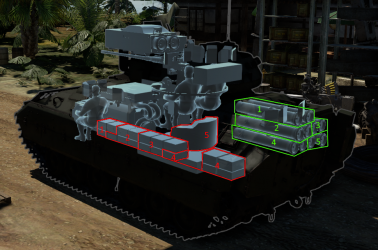
| Full ammo |
1st rack empty |
2nd rack empty |
3rd rack empty |
4th rack empty |
Visual discrepancy |
|---|---|---|---|---|---|
| 5 | 4 (+1) | 3 (+2) | 2 (+3) | 1 (+4) | No |
Additional armament
The M3 Bradley comes equipped with a BGM-71B TOW ATGM launcher. The launcher contains two TOW missiles, which can be fired one after another in quick succession. Then, they are reloaded. Before you can fire, though, you have to be either stopped or moving at very low speeds, around 5 km/h. At higher speeds, the launcher folds up against the turret. When you stop, it takes time for the launcher to unfold before you can fire. This is where cruise control can be important. The first cruise control setting for forward and reverse speed is the "battle" setting. This controls the speed of the vehicle to where it is slow enough that you can fire the TOW missiles on the move. As before stated, this speed is very low, only about 5 km/h, so you should probably not drive in this mode of cruise control for the whole battle.
| BGM-71A TOW missile | ||||
|---|---|---|---|---|
| Capacity (Belt) | Vertical | Horizontal | Stabilizer | |
| 12 (2) | -19°/+29° | N/A | N/A | |
Ammunition
| Penetration statistics | |||||||
|---|---|---|---|---|---|---|---|
| Ammunition | Type of warhead |
Penetration @ 0° Angle of Attack (mm) | |||||
| 10 m | 100 m | 500 m | 1,000 m | 1,500 m | 2,000 m | ||
| TOW | ATGM | 430 | 430 | 430 | 430 | 430 | 430 |
| Missile details | ||||||||||||
|---|---|---|---|---|---|---|---|---|---|---|---|---|
| Ammunition | Type of warhead |
Velocity (m/s) |
Range (m) |
Projectile mass (kg) |
Fuse delay (m) |
Fuse sensitivity (mm) |
Explosive mass (TNT equivalent) (kg) |
Ricochet | ||||
| 0% | 50% | 100% | ||||||||||
| TOW | ATGM | 299 | 3,000 | 18.82 | 0.05 | 0.1 | 3.75 | 80° | 82° | 90° | ||
Ammo racks

| Full ammo |
1st rack empty |
2nd rack empty |
3rd rack empty |
4th rack empty |
5th rack empty |
Visual discrepancy |
|---|---|---|---|---|---|---|
| 12 | 10 (+2) | 8 (+4) | 6 (+6) | 4 (+8) | 2 (+10) | Yes |
Machine guns
| 7.62 mm M240 | ||||
|---|---|---|---|---|
| Mount | Capacity (Belt) | Fire rate | Vertical | Horizontal |
| Coaxial | 4,400 (200) | 941 | N/A | N/A |
Usage in battles
One way the Bradley can be played is as an ambush vehicle. Find a good location where you have sufficient protective cover to secure your position, but where you can see at least one lane of attack that the enemy is likely to use. Since you will be sitting still, your TOW launcher will be deployed, and you can fire TOW missiles whenever you need to. The best way to use the TOW missiles is to hit the enemy in the side. Two TOW missiles to the side should almost always kill a tank if well aimed.
Another way to use the Bradley is to get hull down, at long range and use the TOW launcher to deadly effect. Since you do not have to calculate for drop for ATGMs, you should be able to reliably hit your target and do major damage. Because you are firing at such long-range, it is likely the enemy will not spot you in time to shoot at you, or they will miss at least their first shot.
The Bradley can also be used effectively in urban combat. If you pick a side street to set up, when the enemy goes past, hopefully without seeing you, you will be able to hit them in the side with the TOW launcher.
In arcade mode, the Bradley can be used very effectively as an anti-aircraft vehicle. Since in arcade you get a lead indicator, you should be able to accurately hit planes and helicopters. When using the HEI-T* ammunition one to two hits is usually fatal for an aircraft. TOW missiles can be used to great effect against helicopters as well, but it is probably smarter to save the ATGMs for ground targets. Also, it can be hard to hit a moving helicopter with an ATGM for someone who's inexperienced with ATGMs.
One last note: the TOW missiles should be your primary weapon, not your autocannon. Firing the autocannon will likely give away your position instantly, so unless you have already been seen, or if you know you can kill the target quickly, do not use the autocannon. The autocannon can not effectively destroy tanks but is mostly just effective against SPAA's and light tanks. Those targets can also kill you very easily though, so it is almost always better to use the TOW missiles, in order to destroy the enemy tank quickly and efficiently. On the other hand, if an enemy tank is at close range, and has spotted you, you can often use the autocannon to damage or destroy their gun barrel with multiple, well-aimed, shots, to buy yourself more time.
Pros and cons
Pros:
- Excels at urban combat, as the gun can be effective when engaging MBTs, except for the Russian MBTs
- Outclasses stock 35 mm autocannon tanks which use API or APHE as long as long-range (about 1.1 km) and moderate front armour angle is kept, can even sustain low calibre APDS and HVAP hits from spaded light tanks if it has the high ground
- Can fire missiles at "combat" cruise control, albeit only at about 5 km/h (can be considered as a downgrade after M551, but still usable when compared to its peers)
- 25 mm autocannon can easily tear through light vehicles and is useful for engaging helicopters
- TOW missiles capable of penetrating many tanks from the front with ease
- Has a fast turret traverse and two-plane stabilizer, allowing for quick reaction times and accurate fire on the move
- Slow ATGM allows for easier aiming onto target
- Has access to first generation gunner thermals
- Can fire two missiles in a row before reloading
Cons:
- Additional side armour plates and turret frontal slope protect against 12.7 machine guns, but will always set off APHE, so caution is required
- Low fire rate on the autocannon; faster than the British 30 mm RARDEN but slower than the Russian 30 mm 2A42 and most SPAA autocannons
- Survivability is poor as with other IFVs; its autocannon belt is easy to hit and the vehicle is prone to overpressure
- Relatively slow, especially in reverse
- Large size makes it easy to spot
- Engine, transmission, and driver at front of the vehicle are very prone to damage
- Only has access to basic TOW missiles; struggles against later tanks with composite and explosive reactive armor
- Cannot fire missiles on the move and must raise the launcher before firing
- Low thermal sight resolution in comparison to the Warrior
- Loud and noticeable engine sound
- Default and M792 belts perform poorly against heavier targets
- Prone to overpressure; explosive rounds with enough filler hitting the turret will usually knock it out
- Does not have access to a laser rangefinder
History
Development of the Bradley began in the late 1950s when the U.S. Army began seeking a replacement for the ageing M113 APC. However, despite beginning development relatively early, the successor to the M113 wouldn't enter service with the Army in the following two decades.
The reason behind this was the constantly changing specifications, requirements and doctrines around which the new vehicle would be designed. The constantly changing requirements, on the other hand, were driven by various technical and political problems arising during development.
Eventually, in 1979, the final design was presented to the Army and production was approved shortly afterwards in 1980. The Bradley, named after WW2 Army General Omar Bradley, was split into two versions, both closely resembling each other, but featuring minor differences and intended for different roles.
While the M2 Bradley was intended as an IFV, capable of transporting and supporting infantry units in combat, the M3 Bradley CFV (Cavalry Fighting Vehicle) is intended to perform scouting and reconnaissance work, ditching its infantry-carrying ability in favour of improved communications systems and increased ammunition capacity.
The Bradley entered service with the U.S. Army in 1981 and saw extensive combat use during the Gulf War as well as subsequent conflicts. Despite several (unsuccessful) efforts being made to replace the Bradley with a newer design, the vehicle still remains in active service with U.S. armed forces today, with over 6,500 units produced.
- From Devblog
Media
- Skins
- Images
- Videos
See also
- Similar IFVs of other nations
External links
| Food Machinery Corporation (FMC) | |
|---|---|
| Amphibious AFVs | LVT(A)(1) · LVT(A)(4) |
| IFVs | M3 Bradley · M3A3 Bradley |
| USA light tanks | |
|---|---|
| LVT | LVT(A)(1) · ○LVT(A)(1) · LVT(A)(4) |
| M2 | M2A2 · M2A4 · M2A4 (1st Arm.Div.) |
| M3/M5 Stuart | M3 Stuart · M3A1 Stuart · M3A1 (USMC) · M5A1 · M5A1 TD · ▃Stuart VI (5th CAD) |
| M22 Locust | M22 |
| M24 Chaffee | M24 · M24 (TL) |
| M18 Hellcat | M18 GMC · M18 "Black Cat" · Super Hellcat |
| M41 Walker Bulldog | M41A1 |
| M551 Sheridan | M551 · M551(76) |
| M3 Bradley | M3 Bradley · M3A3 Bradley |
| Wheeled | M8 LAC · T18E2 · M1128 · M1128 Wolfpack |
| Other | M8A1 GMC · T92 · T114 · HSTV-L · CCVL · XM8 · XM800T · AGS |


